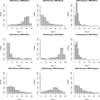Associations of Genetically Determined Continental Ancestry With CD4+ Count and Plasma HIV-1 RNA Beyond Self-Reported Race and Ethnicity
- PMID: 26536313
- PMCID: PMC4788562
- DOI: 10.1097/QAI.0000000000000883
Associations of Genetically Determined Continental Ancestry With CD4+ Count and Plasma HIV-1 RNA Beyond Self-Reported Race and Ethnicity
Abstract
Background: Ancestry informative markers (AIMs) measure genetic admixtures within an individual beyond self-reported racial/ethnic (SRR) groups. Here, we used genetically determined ancestry (GDA) across SRR groups and examine associations between GDA and HIV-1 RNA and CD4 counts in HIV-positive children in the United States.
Methods: Forty-one AIMs, developed to distinguish 7 continental regions, were detected by real-time PCR in 994 HIV-positive, antiretroviral naive children. GDA was estimated comparing each individual's genotypes to allele frequencies found in a large set of reference individuals originating from global populations using STRUCTURE. The means of GDA were calculated for each category of SRR. Linear regression was used to model GDA on CD4 count and log10 RNA, adjusting for SRR and age.
Results: Subjects were 61% black, 25% Hispanic, 13% white, and 1.3% Unknown. The mean age was 2.3 years (45% male), mean CD4 count of 981 cells per cubic millimeter, and mean log10 RNA of 5.11. Marked heterogeneity was found for all SRR groups with high admixture for Hispanics. In adjusted linear regression models, subjects with 100% European ancestry were estimated to have 0.33 higher log10 RNA levels (95% CI: 0.03 to 0.62, P = 0.028) and 253 CD4 cells per cubic millimeter lower (95% CI: -517 to 11, P = 0.06) in CD4 count, compared to subjects with 100% African ancestry.
Conclusion: Marked continental admixture was found among this cohort of HIV-infected children from the United States. GDA contributed to differences in RNA and CD4 counts beyond SRR and should be considered when outcomes associated with HIV infection are likely to have a genetic component.
Conflict of interest statement
Figures


References
-
- Witzig R. The medicalization of race: scientific legitimization of a flawed social construct. Annals of Internal Medicine. 1996;125(8):675–679. - PubMed
-
- Burchard EG, Ziv E, Coyle N, et al. The importance of race and ethnic background in biomedical research and clinical practice. New England Journal of Medicine. 2003;348(12):1170–1175. - PubMed
-
- Kaufman JS, Cooper RS. Commentary: considerations for use of racial/ethnic classification in etiologic research. American Journal of Epidemiology. 2001;154(4):291–298. - PubMed
-
- Johnson J. Predictability of the effects of race or ethnicity on pharmacokinetics of drugs. International journal of clinical pharmacology and therapeutics. 2000;38(2):53–60. - PubMed
Publication types
MeSH terms
Substances
Grants and funding
- UM1AI106716/AI/NIAID NIH HHS/United States
- R03 MH103995/MH/NIMH NIH HHS/United States
- U01 AI068632/AI/NIAID NIH HHS/United States
- UM1 AI068632/AI/NIAID NIH HHS/United States
- M01 RR016587/RR/NCRR NIH HHS/United States
- UM1AI068632/AI/NIAID NIH HHS/United States
- R01 NS077874/NS/NINDS NIH HHS/United States
- UM1 AI068616/AI/NIAID NIH HHS/United States
- UM1AI068616/AI/NIAID NIH HHS/United States
- R01 MH085608/MH/NIMH NIH HHS/United States
- UM1 AI106716/AI/NIAID NIH HHS/United States
- UM1 AI069536/AI/NIAID NIH HHS/United States
LinkOut - more resources
Full Text Sources
Other Literature Sources
Medical
Research Materials

